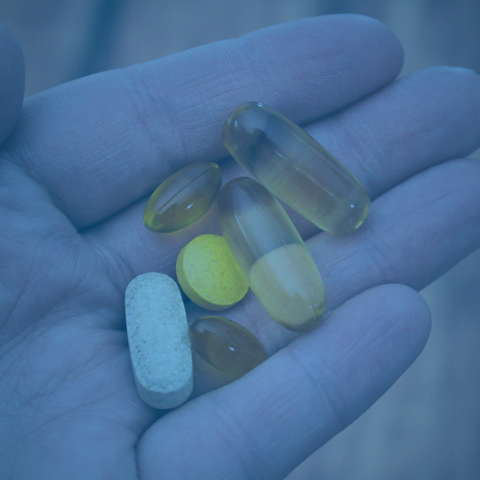
Cannabigerol (CBG) is a non-psychoactive compound and a member of resorcinols found in Cannabis sativa and Helichrysum species. While other phytocannabinoids have been studied extensively, like cannabidiol or Δ9-tetrahydrocannabinol, CBG has been neglected for years because of its lower concentration in plants. However, there is now growing interest in this molecule. CBG is a potent agonist (activator) of the α-2 adrenergic receptor (ADRA2A); an agonist of the peroxisome proliferator activated receptor γ (PPARγ); an agonist of all of the transient receptor potential (TRP) family channels, except TRPM8, for which it is an antagonist (blocker); and an antagonist of the serotonin 1A receptor (5-HT1A ). In addition, CBG is a partial agonist of the cannabinoid receptors 1 (CB1) and 2 (CB2) [1,2].
Pre-clinical findings show that CBG has many pharmacological effects. It possesses neuroprotective and neuromodulation properties, and has anti-inflammatory, anti-tumoral, antinociceptive, and anti-bacterial effects, among others [3].
Neuroprotective activity
CBG shows clear neuroprotective effects both in vitro and in vivo.
Indeed, CBG showed neuroprotective effects by reducing oxidative neurotoxicity induced by hydrogen peroxide (causing oxidative stress) and rotenone (causing mitochondrial dysfunction) in neural cell cultures. To determine whether CB1, CB2, or 5-HT1A receptors were involved, antagonists of each receptor were added to the neural cells. WAY100635 ( a 5-HT1A antagonist) decreased the CBG neuroprotective effect against rotenone, while CB1 and CB2 antagonists had no effect. These results suggest that CBG neuroprotection against oxidative neurotoxicity derives from a 5-HT1A-mediated process while CB1 and CB2 are not involved [4].
It also showed beneficial neuroprotective effects in an in vitro model of neuroinflammation. CBG prevented neuronal apoptosis by increasing Bcl-2, decreasing cleaved caspase-3, and inhibiting Bax expression compared to untreated-CBG neurons in culture with lipopolysaccharide-stimulated macrophages. CBG also reduced pro-inflammatory cytokine (i.e., IL-1β, TNF-α, and IFN-γ) and PPARγ protein levels [5].
In another study, CBG was administered to R6/2 mice, an in vivo model of Huntington’s disease (HD), and followed by genomic analyses. The results showed that CBG partially restored the abnormal gene expression associated with HD compared to untreated cells. This correction involved genes such as symplekin, histone deacetylase 2, huntingtin-associated protein 1, and the δ subunit of the GABA-A receptor, among others. CBG also exhibited a modest enhancement in the gene expressions of brain-derived neurotrophic factor, insulin-like growth factor-1, and PPARγ, which were initially disrupted in this HD model [6]. Therefore, CBG could present neuroprotective properties in the context of HD.
Similarly, CBG was administered to PC12 cells in culture with amyloid β protein fragment 1-42 (Aβ1-42), an in vitro model of Alzheimer’s disease (AD). CBG showed significant protective effects against Aβ1-42-induced toxicity, as assessed through transmission electron microscopy experiments measuring morphological changes and neurite damage. PC12 cells treated with CBG and Aβ1-42 displayed a very similar morphology to the control cells, and CBG treatment promoted the presence of growth cones indicative of neurite outgrowth. However, CBG did not affect Aβ1-42 aggregation or lipid peroxidation (as assessed by cell treatment with tert-butyl hydroperoxide), suggesting that CBG's neuroprotective effect is independent of its antioxidant activity and may be related to its anti-inflammatory activity through PPARγ, which acts as a modulator of pro-inflammatory cytokine release [7].
Neuromodulation activity
Another study focused on CBG influence over the transcriptomic profile of NSC-34 motor neuron-like cells and highlighted several mechanisms of CBG neuromodulation. Thus, CBG treatment reduced the expression of glutamate release genes. Glutamate, an excitatory neurotransmitter in the brain, plays crucial roles in synaptic transmission, plasticity, neuronal migration, and excitability. CBG also enhanced the expression of GABA release genes. GABA, an inhibitory neurotransmitter, modulates the synaptic transmission and promotes neuronal development. Finally, CBG up-regulated dopamine D4 receptor and its downstream effectors. Dopamine is known to regulate motor functions, motivation, cognition, emotions, and neuroendocrine secretions [2].
Anti-inflammatory activity
CBG shows promising anti-inflammatory properties in human skin cells. CBG treatment of human dermal fibroblasts, cultivated with pro-inflammatory inducers to trigger cytokine production and oxidative stress, showed that CBG reduced reactive oxygen species better than Vitamin C.
CBG also presented anti-inflammatory properties against ultraviolet A and B by preventing the release of pro-inflammatory cytokines IL-1β, IL-6, IL-8, and TNF-α [8].
CBG anti-inflammatory activity was also studied in a chemically induced colitis model in mice. In intestinal epithelial cells, CBG treatment reduced iNOS expression and myeloperoxidase activity. It reduced the changes induced by dinitrobenzene sulfonic acid treatment by normalizing interleukin-1β, interleukin-10, and interferon-γ levels, and decreasing neutrophil infiltration. Focusing on macrophages, CBG reduced nitric oxide production and iNOS in a CB2-dependent manner [9].
Antitumoral activity
At higher concentrations, CBG presents anti-neoplastic properties as demonstrated in colorectal cancer cells. In these cells, CBG promoted apoptosis by stimulating reactive oxygen species production, up-regulating CHOP expression (protein involved in endoplasmic reticulum stress-induced apoptosis), and thus reducing cancer cells' growth. Further analyses showed that CBG effects were independent from TRP channels (TRPA1, TRPV1, and TRPV2) activation, enhanced by a CB2 antagonist, and mimicked by TRPM8 but not 5-HT1A antagonists. In a mouse model of colon cancer, CBG was able to slow down colon cancer progression by selectively inhibiting cancer cells' growth, an effect already observed with other TRPM8 antagonists [10].
Antinociceptive activity
CBG also demonstrated antinociceptive effects in different pain models. Indeed, CBG was able to reduce pain in a carrageenan-induced inflammatory pain model, a CIA-induced arthritis pain model, and a nerve pain model in mice. CBG antinociceptive mechanism was linked to TRPV1 activation and desensitization that blocked pain signal transmission. Moreover, the observed antinociceptive effect was greatly supported by the release of β-endorphin triggered by CBG-activated CB2 [11]. Therefore, CBG is a promising molecule for pain management.
Intraocular pressure (IOP) reduction activity
CBG can reduce intraocular pressure (IOP) and to a greater extent when administered chronically in various species, without causing any side effects such as conjunctival erythema or hyperemia. Although the CBG mechanism on IOP remains unclear, the study of a CBG analogue (cannabigerol-dimethyl heptyl) revealed that IOP reduction in normotensive rat eyes was independent of CB1 or CB2, suggesting the existence of putative cannabinoid receptors in ocular tissues [3].
Antibacterial activity
CBG shows interesting antibacterial properties. It was found to be one of the most potent cannabinoids tested against antibiotic-resistant strains of Staphylococcus aureus (S. aureus) [12]. CBG was as effective as vancomycin in reducing colony-forming units of methicillin-resistant S. aureus by inhibiting its ability to form biofilms, and eradicating preformed biofilms through its cytoplasmic membrane targeting. CBG also exhibited antibacterial effects on gram-negative bacteria by targeting their inner membrane, but only after permeabilization of their outer membrane [13].
CBG also exerts anti-bacterial effects against Streptococcus mutans (S. mutans). Diverse experiments showed that CBG altered the S. mutans membrane, modifying its properties through hyperpolarization and reducing fluidity to finally increase its permeability [14].
Another study showed that CBG is a potential anti-quorum-sensing compound for S. mutans by repressing the expression of comCDE, luxS, and ComE-regulated genes. CBG significantly reduced the 21-CSP-induced expression of comCDE genes and ComE-regulated genes. In addition, it suppressed the expression of luxS with concomitant reduction in AI-2 production [15].
Appetite enhancer
CBG stimulates hyperphagia in rats [16] and thus presents therapeutic potential to treat cachexia and other disorders of eating and body weight regulation. CBG may also represent a novel therapeutic option for chemotherapy-induced cachexia. In a rat model of cisplatin-induced cachexia, CBG partially normalized the cisplatin-induced weight loss, anorexia, and aberrant metabolic phenotype. Additionally, CBG rescued cisplatin-induced dysregulation of myofiber autophagy. At the molecular level, it preserved protein synthesis by reversing the inhibition of Akt/S6-mediated protein synthesis, and thus prevented muscle fiber atrophy. CBG also reversed cisplatin effects on LC3 and p62 expression, indicating the normalization of the homeostatic autophagy function and preventing pathological muscle catabolism [17].
Anti-aging potential
Genomics analyses of skin cells revealed that CBG regulates several key skin targets, which suggests promising anti-aging potential. CBG greatly increased the expression of collagen I, III, and IV, and elastin, essential proteins for skin elasticity. It also promoted the expression of fibronectin, playing a key role in cell growth and wound healing, and fibroblast growth factor 2, important in winkle reduction by promoting regeneration and proliferation of skin cells. Finally, CBG also promoted the expression of the tissue inhibitor of metalloproteinase-3, which is a critical factor to prevent ultraviolet-B-induced inflammation [8].
CBG at Troscriptions
CBG works in synergy with CBD, kava, and N-nicotinoyl-GABA in Tro Calm, one of the most novel and most powerful anti-anxiety products on the market. All ingredients are precision-dosed and pharmaceutical-grade, and Tro Calm was extensively tested before its launch in November 2021.
Let the troche dissolve between your upper cheek and gums. In 15 to 30 minutes, you’ll feel the chill and the calm... so you can carry on!
Conclusion
While CBG exhibits numerous potential therapeutic effects, its limited concentration in plants currently hinders the understanding of possible side effects in humans. However, CBG has proved to be a potent agonist of ADRA2A, which may lead to unintended cardiovascular effects (such as bradycardia or hypotension) and xerostomia [1]. A thorough understanding of its various modes of action is imperative before considering any therapeutic applications of CBG in humans, therefore, additional studies are essential. CBG is currently under assessment in several clinical trials. One clinical trial (NCT05743985) aims to explore the in vivo physiological effects of CBG in healthy volunteers, while others focus on its safety and efficacy profile for various indications, such as sleep disturbances, anxiety, appetite loss, or attention-deficit/hyperactivity disorder.
References
[1] Nachnani, R., Raup-Konsavage, W.M., and Vrana, K.E. (2021) The Pharmacological Case for Cannabigerol. Journal of Pharmacology and Experimental Therapeutics, 376, 204–12. https://doi.org/10.1124/jpet.120.000340
[2] Gugliandolo, A., Silvestro, S., Chiricosta, L., Pollastro, F., Bramanti, P., and Mazzon, E. (2020) The Transcriptomic Analysis of NSC-34 Motor Neuron-Like Cells Reveals That Cannabigerol Influences Synaptic Pathways: A Comparative Study with Cannabidiol. Life, 10, 227. https://doi.org/10.3390/life10100227
[3] Calapai, F., Cardia, L., Esposito, E., Ammendolia, I., Mondello, C., Lo Giudice, R., et al. (2022) Pharmacological Aspects and Biological Effects of Cannabigerol and Its Synthetic Derivatives. Taglialatela Scafati O, editor. Evidence-Based Complementary and Alternative Medicine, 2022, 1–14. https://doi.org/10.1155/2022/3336516
[4] Echeverry, C., Prunell, G., Narbondo, C., De Medina, V.S., Nadal, X., Reyes-Parada, M., et al. (2021) A Comparative In Vitro Study of the Neuroprotective Effect Induced by Cannabidiol, Cannabigerol, and Their Respective Acid Forms: Relevance of the 5-HT1A Receptors. Neurotoxicity Research, 39, 335–48. https://doi.org/10.1007/s12640-020-00277-y
[5] Gugliandolo, A., Pollastro, F., Grassi, G., Bramanti, P., and Mazzon, E. (2018) In Vitro Model of Neuroinflammation: Efficacy of Cannabigerol, a Non-Psychoactive Cannabinoid. International Journal of Molecular Sciences, 19, 1992. https://doi.org/10.3390/ijms19071992
[6] Valdeolivas, S., Navarrete, C., Cantarero, I., Bellido, M.L., Muñoz, E., and Sagredo, O. (2015) Neuroprotective Properties of Cannabigerol in Huntington’s Disease: Studies in R6/2 Mice and 3-Nitropropionate-lesioned Mice. Neurotherapeutics, 12, 185–99. https://doi.org/10.1007/s13311-014-0304-z
[7] Marsh, D.T., Sugiyama, A., Imai, Y., Kato, R., and Smid, S.D. (2024) The structurally diverse phytocannabinoids cannabichromene, cannabigerol and cannabinol significantly inhibit amyloid β‐evoked neurotoxicity and changes in cell morphology in PC12 cells. Basic & Clinical Pharmacology & Toxicology, 134, 293–309. https://doi.org/10.1111/bcpt.13943
[8] Perez, E., Fernandez, J.R., Fitzgerald, C., Rouzard, K., Tamura, M., and Savile, C. (2022) In Vitro and Clinical Evaluation of Cannabigerol (CBG) Produced via Yeast Biosynthesis: A Cannabinoid with a Broad Range of Anti-Inflammatory and Skin Health-Boosting Properties. Molecules, 27, 491. https://doi.org/10.3390/molecules27020491
[9] Borrelli, F., Fasolino, I., Romano, B., Capasso, R., Maiello, F., Coppola, D., et al. (2013) Beneficial effect of the non-psychotropic plant cannabinoid cannabigerol on experimental inflammatory bowel disease. Biochemical Pharmacology, 85, 1306–16. https://doi.org/10.1016/j.bcp.2013.01.017
[10] Borrelli, F., Pagano, E., Romano, B., Panzera, S., Maiello, F., Coppola, D., et al. (2014) Colon carcinogenesis is inhibited by the TRPM8 antagonist cannabigerol, a Cannabis-derived non-psychotropic cannabinoid. Carcinogenesis, 35, 2787–97. https://doi.org/10.1093/carcin/bgu205
[11] Wen, Y., Wang, Z., Zhang, R., Zhu, Y., Lin, G., Li, R., et al. (2023) The antinociceptive activity and mechanism of action of cannabigerol. Biomedicine & Pharmacotherapy, 158, 114163. https://doi.org/10.1016/j.biopha.2022.114163
[12] Appendino, G., Gibbons, S., Giana, A., Pagani, A., Grassi, G., Stavri, M., et al. (2008) Antibacterial Cannabinoids from Cannabis sativa : A Structure−Activity Study. Journal of Natural Products, 71, 1427–30. https://doi.org/10.1021/np8002673
[13] Farha, M.A., El-Halfawy, O.M., Gale, R.T., MacNair, C.R., Carfrae, L.A., Zhang, X., et al. (2020) Uncovering the Hidden Antibiotic Potential of Cannabis. ACS Infectious Diseases, 6, 338–46. https://doi.org/10.1021/acsinfecdis.9b00419
[14] Aqawi, M., Sionov, R.V., Gallily, R., Friedman, M., and Steinberg, D. (2021) Anti-Bacterial Properties of Cannabigerol Toward Streptococcus mutans. Frontiers in Microbiology, 12, 656471. https://doi.org/10.3389/fmicb.2021.656471
[15] Aqawi, M., Sionov, R.V., Friedman, M., and Steinberg, D. (2023) The Antibacterial Effect of Cannabigerol toward Streptococcus mutans Is Influenced by the Autoinducers 21-CSP and AI-2. Biomedicines, 11, 668. https://doi.org/10.3390/biomedicines11030668
[16] Brierley, D.I., Samuels, J., Duncan, M., Whalley, B.J., and Williams, C.M. (2016) Cannabigerol is a novel, well-tolerated appetite stimulant in pre-satiated rats. Psychopharmacology, 233, 3603–13. https://doi.org/10.1007/s00213-016-4397-4
[17] Brierley, D.I., Harman, J.R., Giallourou, N., Leishman, E., Roashan, A.E., Mellows, B.A.D., et al. (2019) Chemotherapy‐induced cachexia dysregulates hypothalamic and systemic lipoamines and is attenuated by cannabigerol. Journal of Cachexia, Sarcopenia and Muscle, 10, 844–59. https://doi.org/10.1002/jcsm.12426




Comments (1)
I found your product to be very effective , especially when it comes to energy levels , productivity and clarity. The only reason I haven’t purchased any more as of yet is I need to stop taking mirtazapine.